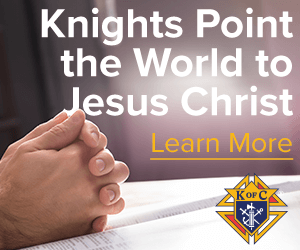Advent is a time when we await the birth of Christ, the Messiah. But it is also a time when we focus on the anticipation we feel in our own age for the Second Coming of Christ. What can Advent teach us that will help us to prepare for the coming of the Messiah at the end of time?
Msgr. Stuart Swetland recently focused on this question during his Catechetical Corner on Go Ask Your Father™. He pointed to paragraph 524 of the Catechism of the Catholic Church, which says, “When the Church celebrates the liturgy of Advent each year, she makes present this ancient expectancy of the Messiah, for by sharing in the long preparation for the Savior’s first coming, the faithful renew their ardent desire for his second coming.”
And how can we prepare as we await the Messiah? Msgr. Swetland encouraged listeners to look to Scripture for clues. He said, “We’re in that part of Advent when we are listening very attentively to the prophets, especially the prophet Isaiah, and all the passages that points to the coming of God in a new way into history. That there will be this servant who will be a suffering servant, and will come among us as a savior of Israel. And, of course, a sign of that is the one that comes to prepare the way.”
The Sunday Gospels in the last few weeks have focused on John the Baptist, who called others to prepare the way for the Lord. John called for repentance, but Msgr. Swetland pointed out that John also taught us about the spiritual life, and how that starts with humility.
“John taught us that ‘He must increase, but I must decrease,’ Msgr. Swetland said. “That’s kind of the first law the spiritual life.”
Humility is a theme that can be found surrounding the birth of Christ. Pope Francis pointed to the humility that Christ modeled in his apostolic letter Admirabile Signum, on the meaning and importance of the nativity scene. And paragraph 525 in the Catechism tells us: “Jesus was born in a humble stable into a poor family. Simple shepherds were the first witnesses to this event. In this poverty, heaven’s glory was made manifest.”
Msgr. Swetland pointed out an aspect of the nativity scene that is often overlooked, but carries a deep meaning for us as we await the Second Coming of Christ. He said, “One of the sacramental symbols of our creche and manger is that we place there an ox and a donkey. This points back to the very beginning of Isaiah’s prophecy. Isaiah 1:3 says ‘Listen, O heavens and give ear O earth, for the Lord has spoken. I have raised children and brought them up, but they have rebelled against Me. The ox knows its owner and the donkey its master, but Israel does not know, My people do not understand.'”
“Here we see symbol that the ox and the ass know their master,” Msgr. Swetland said. “In other words, nature in a way knows the Lord of Nature. And we had been forgetful, or inattentive, or had not be listening, or had not lived in accordance with the truth of who we are and why we are. But in Jesus, we have the chance to be renewed, to repent, to begin to return, to learn how to live and how to love. And every part of his life reveals this to us, especially for today’s reflection, his humility and his poverty.”
What are some ways that you can practice humility this Advent, allowing yourself to decrease so that the Lord may increase?
Listen to the full Catechetical Corner below:
Go Ask Your Father weekdays at 1:00 p.m. Eastern/10:00 a.m. Pacific on Relevant Radio® and the Relevant Radio App.

